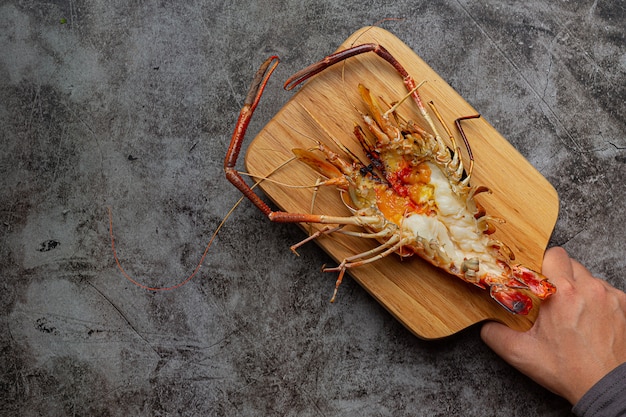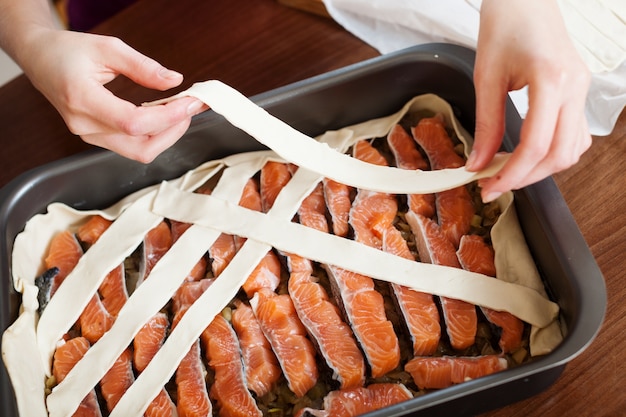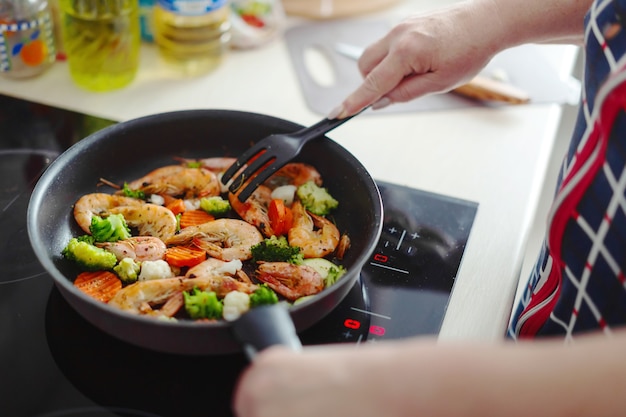The thought of a succulent, perfectly cooked lobster tail, glistening with butter and bursting with flavor, can send anyone’s taste buds into overdrive. But for those who aren’t culinary wizards, the prospect of tackling a lobster tail might seem a little intimidating. Fear not! I’m here to guide you through the process of creating a delicious oven-baked lobster tail, proving that even novice cooks can achieve impressive results.
Over the years, I’ve learned that baking lobster tails is surprisingly easy and incredibly rewarding. It’s a dish that elevates any meal, making it special, whether it’s a romantic dinner for two or a celebratory feast for friends and family. So, grab your apron, put on some good music, and let’s dive into the wonderful world of lobster tail baking!
Part 1: Choosing Your lobster tails

The journey to a delectable lobster tail begins with selecting the perfect specimens. It’s like picking out a prized piece of jewelry—you want something that catches your eye and promises a truly special experience.
Picking the Right Size
Lobster tails come in a range of sizes, each offering a unique experience. For a statement piece, go for a jumbo tail, weighing around 8-10 ounces. These majestic tails are sure to impress and deliver a truly satisfying portion. But don’t shy away from smaller tails, which are just as delicious, offering a delightful balance of flavor and affordability. Ultimately, the size is a matter of personal preference and budget.
Recognizing Freshness
When it comes to lobster tails, freshness is paramount. It’s the key to unlocking their full flavor potential. Here's how to make sure you're getting the freshest catch:
- The Shell: A fresh lobster tail boasts a shell that’s firm and shiny, almost like polished armor. Avoid tails with a dull or soft shell, as they might not be at their peak.
- The Meat: Peeking under the tail, you should find firm, white meat. Any mushy or discoloured areas are a sign that the lobster tail is not fresh.
- The Smell: The true test of freshness lies in the aroma. A fresh lobster tail should smell like the ocean, with a hint of brininess. If you detect any fishy or ammonia-like odor, steer clear.
If you're ever unsure, don’t hesitate to ask the fishmonger for their expert opinion. They’re a treasure trove of knowledge when it comes to seafood, and they’re more than happy to guide you towards the freshest tails.
Part 2: Prepping Your Lobster Tails

Now that you’ve chosen your lobster tails, it’s time to give them some TLC, ensuring they’re ready for their transformation into culinary delights.
thawing frozen lobster tails
If you’ve purchased frozen lobster tails, don’t rush to bake them straight away. The key here is patience. The best way to thaw them is overnight in the fridge. This gentle, gradual thawing process ensures that the meat retains its delicate texture and moisture.
Cleaning Your Lobster Tails
Once your lobster tails are thawed, it’s time for a little cleaning. A quick rinse under cold water will remove any lingering grit or impurities. Gently pat them dry with paper towels to ensure they’re ready for the oven.
Part 3: The Baking Process

Now for the heart of the matter: the baking process itself. This is where the magic happens, transforming your lobster tails into a gastronomic masterpiece.
Choosing Your Baking Method
There are two popular methods for baking lobster tails:
- In-Shell Baking: This traditional method involves baking the lobster tails in their natural shells. It delivers a beautifully cooked lobster, with a rich, nuanced flavor, and an aroma that fills your kitchen with the essence of the sea.
- Out-of-Shell Baking: This method involves removing the meat from the shell and baking it separately. It’s a great option for those who prefer a little more control over the cooking process and allows for creative flavor combinations.
Personally, I find the in-shell method to be a truly authentic way to experience the full flavor and aroma of lobster. It’s a simple, elegant approach that emphasizes the beauty of the natural ingredients.
Preparing Your Lobster Tails for Baking
Now it's time to make those tails truly shine with a few simple preparations:
- Seasoning: A sprinkle of salt and pepper is all you need to enhance the lobster’s natural sweetness. Don’t overpower the delicate flavors with excessive seasoning.
- Butter: A pat of butter on top of each tail is like a luxurious hug, keeping the meat moist and adding a touch of richness.
- Lemon: A squeeze of fresh lemon juice brightens the flavor profile and adds a delightful citrusy aroma.
Remember, less is more when it comes to seasoning. You want to enhance the lobster’s natural flavors, not overwhelm them.
Baking Your Lobster Tails
Finally, we reach the grand finale! Let’s get those lobster tails baking to perfection:
- Preheat: Set your oven to 400°F (200°C). A preheated oven ensures even cooking and a beautiful golden hue on your lobster tails.
- Baking Time: Bake for 10-12 minutes for a medium-sized tail, or 15-20 minutes for a large tail. Keep a close eye on them, as cooking times can vary slightly.
- Check for Doneness: A perfectly cooked lobster tail has opaque, firm meat. To check, gently probe the thickest part of the tail with a fork. If it comes out easily, it’s ready to be enjoyed.
The key is to avoid overcooking, which can lead to tough, rubbery meat. It’s better to err on the side of undercooked than overcooked.
Part 4: Serving Your Perfect Oven-Baked Lobster Tail
You’ve reached the culmination of your culinary journey – your lobster tails are beautifully baked and ready to be enjoyed. Now, let's present them with a touch of elegance and style.
Presentation Tips
Serving lobster tails is an art form in itself. These simple tips will help you create a visually stunning presentation:
- Plating: A simple white plate allows the beauty of the lobster tail to take center stage. Add a touch of color and visual appeal with a sprig of fresh parsley or a slice of lemon.
- side dishes: Classic side dishes like roasted asparagus, creamy mashed potatoes, or a simple salad complement the flavors of lobster perfectly. These pairings create a well-rounded and delicious dining experience.
- Melting Butter: Don’t forget the final touch! A drizzle of melted butter over the lobster tail adds an extra layer of richness and indulgence.
Serving with Style
To elevate your lobster tail experience, consider setting a romantic table with a tablecloth, candles, and wine glasses. Create an ambiance that reflects the elegance and luxury of your meal. Let your lobster tails take center stage, and savor every delightful bite.
Part 5: Additional Tips and Techniques
Now that you’ve mastered the basics, let’s explore a few additional tips and techniques that will elevate your lobster-baking skills to the next level.
Using a Baking Sheet
For consistent results and effortless cleanup, bake your lobster tails on a baking sheet lined with parchment paper. This will prevent sticking and allow for easy transfer to your serving plate.
Adding Herbs and Spices
Don’t be afraid to experiment with various herbs and spices to add unique flavor profiles to your lobster tails. For a Mediterranean twist, use oregano, thyme, and garlic. If you crave a spicy kick, add a dash of cayenne pepper.
grilled lobster Tails
For an extra smoky flavor, try grilling your lobster tails. Preheat your grill to medium heat and cook for 5-7 minutes per side, until the meat is cooked through and slightly charred.
steamed lobster tails
If you prefer a more delicate flavor, steaming is a great alternative to baking. Place the lobster tails in a steamer basket over boiling water and cook for 8-10 minutes.
Storing Leftovers
If you have any leftover lobster meat, store it in an airtight container in the fridge for up to 3 days. You can reheat it in the oven or microwave for a quick and easy meal.
Part 6: Lobster Tail FAQs
We’ve covered a lot of ground, and you might be brimming with questions about lobster tails. Let’s address some of the most common queries.
1. What’s the Best Way to Crack Open a Lobster Tail?
For efficient and clean cracking, use heavy-duty kitchen shears to cut through the shell lengthwise. Alternatively, use a lobster cracker, a specialized tool designed for this purpose.
2. Can I cook lobster tails in the Microwave?
Microwaving lobster tails is not recommended. It can lead to uneven cooking and a rubbery texture. Stick to baking, grilling, or steaming for the best results.
3. How Can I Tell if a Lobster Tail is Overcooked?
Overcooked lobster tail is a tragedy! The meat will be tough and rubbery, and the shell will have a dull appearance. Keep a close watch on your cooking time and check for doneness before it’s too late.
4. Can I Freeze Cooked Lobster Tails?
It’s best to freeze lobster tails raw. Freezing cooked tails can alter the texture slightly. If you must freeze cooked tails, wrap them tightly in plastic wrap and aluminum foil for optimal protection.
5. What’s the Best Wine Pairing for Lobster Tails?
A dry white wine, like Sauvignon Blanc or Chardonnay, complements the delicate flavors of lobster perfectly. The crisp acidity of these wines cuts through the richness of the lobster, creating a harmonious balance on your palate.
Part 7: My Personal Lobster Tail Experience
Speaking of lobster tails, I have a funny story I just have to share. One time, I was hosting a dinner party and decided to impress my guests with a gourmet lobster tail feast. Everything was going swimmingly until I realized—I’d forgotten the butter! I was panicking, but then I remembered my trusty backup – a jar of delicious homemade garlic butter. It turned out to be the perfect substitute, and everyone loved it. So, don't worry if you don't have all the ingredients – just get creative and make it your own.
Part 8: Conclusion
And there you have it – your comprehensive guide to baking the perfect lobster tails! Remember, it’s all about choosing the right ingredients, preparing them carefully, and baking them to perfection. Most importantly, enjoy the process! It’s a delightful culinary adventure that culminates in a truly satisfying meal. Now go forth, conquer those lobster tails, and impress your friends and family with a memorable feast.
Everyone is watching

Prime Rib Roast Cooking Time Chart: Per Pound Guide
Cooking TipsPrime rib roast. Just the name conjures images of lavish dinners, crackling fires, and hearty laughter. It’s ...

How Long to Bake Potatoes in the Oven (Perfect Every Time)
Cooking TipsBaked potatoes are a staple in my kitchen. They're incredibly versatile, delicious, and surprisingly easy to m...

Perfect Rice Every Time: The Ultimate Guide to Cooking Rice
Cooking TipsAs a self-proclaimed foodie, I've always been a bit obsessed with rice. It's the foundation of countless cuisi...

The Ultimate Guide to Cooking Asparagus: Tips, Techniques, and Recipes
Cooking TipsAsparagus. The mere mention of this spring delicacy conjures up images of vibrant green spears, crisp and burs...

Ultimate Guide to Cooking the Perfect Thanksgiving Turkey
Cooking TipsThanksgiving. Just the word conjures up images of overflowing tables laden with delicious food, the scent of r...
